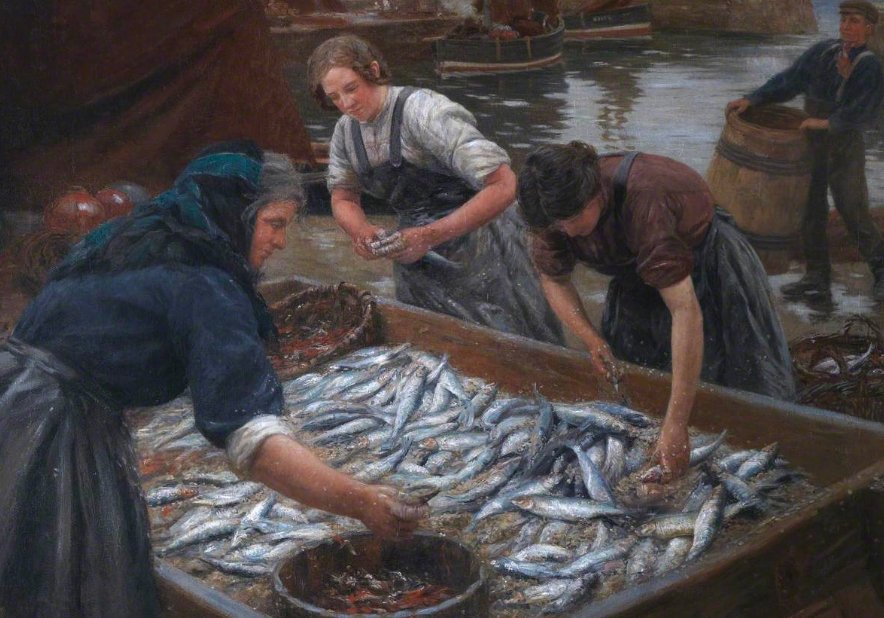Each spring, the North Sea comes alive. Shoals of herring move like liquid silver along Scotland’s coast, following the tiny, fat-rich Calanus copepods that drift south on coastal currents. And for generations, a second migration followed — not of fish, but of people.
Behind the fishermen who hauled in the catch came the women who would make the herring business possible. Known as the Herring Lassies, they gutted, salted, packed, and travelled the length of Britain, carving out a place in industrial history — and defying expectations of what women’s work could be.
Following the Fish
Herring were never a casual catch. They spoiled within a day, sometimes faster, thanks to the rich fat that made them so prized. For centuries, this meant much of the haul went to waste.
The breakthrough came with strict curing standards — fish preserved within hours of landing. This job fell to shore crews, almost entirely made up of women. By the mid-19th century, they had become a workforce in their own right.
They moved with the season: Shetland in May, then down the east coast to Fraserburgh, Peterhead, Wick, and beyond. Some even crossed to English ports like Great Yarmouth in the autumn. The work was cold, wet, and relentless. But it was also a ticket to independence and steady wages at a time when options for women were few.

A Day in the Yard
The herring came ashore in barrels and baskets, still slick from the sea. The Lassies worked in teams of three — two gutters and a packer. The gutters, knives flashing, removed heads and guts in seconds. The packer layered the fish in barrels with coarse salt, her hands red and raw from brine.
Pay was by the barrel. Speed mattered. Pride did, too. In some ports, the best crews could finish a barrel in minutes, earning reputations that spread from Shetland to Lowestoft.
Conditions were tough: long hours in open-air curing yards, with wind biting in from the sea. Oilskins kept some of the cold out, but fingers were always wet. In photographs, the Lassies stand in heavy boots and headscarves, grinning despite the weather.
Women on the Move
One of the most striking things about the Herring Lassies was their mobility. In an era when many women stayed close to home, these crews criss-crossed the country by train and boat, chasing the catch.
They lodged in temporary huts or crowded boarding houses, sometimes sharing floorspace with dozens of other workers. For younger women, the herring season was a rare chance to see new places and meet people from other fishing communities.
It wasn’t without risk — injuries from sharp knives were common, and winter storms could trap them in remote ports. Yet the draw of seasonal wages and camaraderie kept them coming back year after year.
Economic Power in a Male Industry
Fishing was a male-dominated trade, but the Lassies’ work gave them unusual economic clout. In good seasons, skilled gutters could earn more than some male labourers. That income helped support households, paid for siblings’ schooling, or went into savings clubs.
By the early 20th century, the herring industry was one of Scotland’s biggest exports, with cured fish bound for Germany, Russia, and beyond. Without the speed and skill of the Lassies, much of that trade would have been impossible.
Here’s a snapshot from the industry’s heyday:
| Year | Estimated Herring Exports from Scotland | Estimated Number of Herring Lassies Employed |
|---|---|---|
| 1907 | 2.5 million barrels | ~10,000 |
| 1920 | 2.1 million barrels | ~8,500 |
| 1935 | 1.5 million barrels | ~6,000 |
Defying Expectations
In their own quiet way, the Herring Lassies challenged Victorian and Edwardian ideas about women’s roles. They weren’t confined to domestic service or textile mills. They travelled, worked in public, and negotiated directly for pay.
Some contemporary accounts describe them as loud, confident, and quick to stand up for fair treatment. Local newspapers sometimes tutted at their independence, but employers relied on their labour too much to push them out.
A Decline — and a Legacy
The Second World War disrupted the herring trade, and by the 1960s, overfishing and changing markets had gutted it. The curing yards fell silent, and the seasonal migration ended.
Yet the legacy of the Lassies endures. In coastal towns, their contribution is remembered in festivals, heritage projects, and family stories. Museums in Fraserburgh and Shetland keep displays of their oilskins, knives, and photographs — reminders of a time when women stood at the heart of Scotland’s most important export industry.
Their story is more than nostalgia. It’s a reminder that economic history isn’t just about factory owners and politicians — it’s also about the people, often women, whose labour held entire industries together.


















